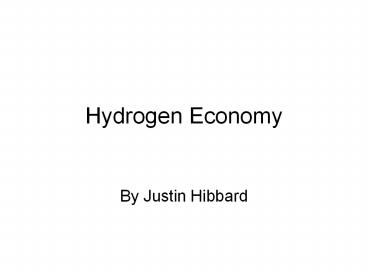Hydrogen Economy - PowerPoint PPT Presentation
Title:
Hydrogen Economy
Description:
Hydrogen Economy By Justin Hibbard Hydrogen Economy Ways to make hydrogen H2 Steam Electrolysis - split water with heat, pressure and electricity Electrolysis - split ... – PowerPoint PPT presentation
Number of Views:289
Avg rating:3.0/5.0
Title: Hydrogen Economy
1
Hydrogen Economy
- By Justin Hibbard
2
Hydrogen Economy
- Ways to make hydrogen H2
- Steam Electrolysis - split water with heat,
pressure and electricity - Electrolysis - split water with electricity
- Direct Solar Thermal Water Splitting split
water with heat - Thermochemical split water using chemicals and
heat - Biological splitting water using sunlight
directly - Steam Reforming convert methane in natural gas
using steam - Direct Thermal Splitting of Natural Gas split
natural gas using heat - Gasification breakdown coal or biomass with
heat and pressure
3
Hydrogen Economy
- Steam Electrolysis - split water with heat,
pressure and electricity - Could be attached to a nuclear power plant.
4
Hydrogen Economy
- Electrolysis - split water with electricity
- 2H2O(l) ? 2H2(g) O2(g) E0 -1.229 V
- Need catalysts to lower energy
5
Hydrogen Economy
- Direct Solar Thermal Water Splitting split
water with heat
Water breaks down at 1700 C. Need ZrO containers
at high temperature. Use multiple reflection
devices and concentrate sunlight. No sunlight,
no energy production.
6
Hydrogen Economy
- Thermochemical split water using chemicals and
heat
- There are more than 200 thermochemical cycles
which can be used for water splitting, around a
dozen of these cycles such as the sulfur-iodine
cycle - The three reactions that produce hydrogen are as
follows - I2 SO2 2H2O ? 2 HI H2SO4 (120C)
- 2 H2SO4 ? 2 SO2 2 H2O O2 (830C)
- 2 HI ? I2 H2 (450C)
- Net reaction 2 H2O ? 2 H2 O2
- Best used with used by fission reactor
7
Hydrogen Economy
Biological splitting water using sunlight
directly
- Algae convert
- Normally plants convert
- CO2 2H2O h? ? CH2O O2 H2O
- Algae engineered by Anastasios Melis, University
of California, Berkeley - O2 sensitive
- Design for less chlorophyll equals absorb less
sunlight. That means more light penetrates into
the deeper algae layers, and eventually, more
cells use the sunlight to make hydrogen.
Algae power While regular green algae absorb most of the light falling on them (right), algae engineered to have less chlorophyll let some light through (left). When grown in large, open bioreactors in dense cultures, the chlorophyll-deficient algae will let sunlight penetrate to the deeper algae layers and thereby utilize sunlight more efficiently. Credit Anastasios Melis, University of California, Berkeley
8
Hydrogen Economy
- Steam Reforming convert methane in natural gas
using steam
- Steam reforming of natural gas or syngas
sometimes referred to as steam methane reforming
(SMR) is the most common method of producing
commercial bulk hydrogen. At high temperatures
(700 1100 C) and in the presence of a
metal-based catalyst (nickel), steam reacts with
methane to yield carbon monoxide and hydrogen.
These two reactions are reversible in nature. - CH4 H2O ? CO 3 H2
- CO H2O ? CO2 H2
- The efficiency of the process is approximately
65 to 75. - CO2 must be sequestered.
9
Hydrogen Economy
- Direct Thermal Splitting of Natural Gas split
natural gas using heat
- The Kværner-process or Kvaerner carbon black
hydrogen process (CBH) is a method for the
production of hydrogen from hydrocarbons (CnHm),
such as methane, natural gas and biogas. - (CnHm) energy ? nC m/2H2
10
Hydrogen Economy
- Switching 100 percent of the algae's
photosynthesis to hydrogen might not be possible.
"The rule of thumb is, if we bring that up to 50
percent, it would be economically viable," Melis
says. With 50 percent capacity, one acre of algae
could produce 40 kilograms of hydrogen per day.
That would bring the cost of producing hydrogen
to 2.80 a kilogram. At this price, hydrogen
could compete with gasoline, since a kilogram of
hydrogen is equivalent in energy to a gallon of
gasoline. - In 2000, Melis, working with researchers at the
National Renewable Energy Laboratory (NREL),
found that depriving the algae of sulfur
nutrients forced the cells to make more hydrogen.
The researchers were only able to deprive the
algae of sulfur for a few days at a time, but
during that time, about 10 percent of the algae's
photosynthetic capacity went toward making
hydrogen. - Researchers at NREL are making progress in
increasing hydrogen-production efficiency,
according to lead researcher Michael Seibert.
They can now force the algae to generate hydrogen
for up to three months, as opposed to just a few
days. Seibert expects that Melis's
chlorophyll-trimmed algae will be useful when the
process is transferred to large bioreactors.
Until the NREL researchers test the mutant algae,
though, he says that it may be too early to tell.
11
Hydrogen Economy
- Gasification breakdown coal or biomass with
heat and pressure
- Coal H2. During gasification, the coal is mixed
with oxygen and steam (water vapor) while also
being heated and pressurized. Also used for
making fuel. - (Coal) O2 H2O ? H2 CO
- CO H2O ? CO2 H2
- CO2 is sequestered.
12
Hydrogen Economy
- Thanks to Rex A. Ewings book Hydrogen Hot Stuff
Cool Science 2nd edition.































